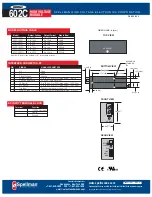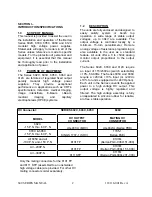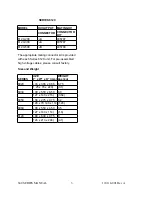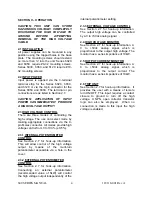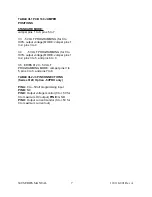
600 SERIES MANUAL
4
118118-001 Rev A
SECTION II – OPERATION
CAUTION: THIS UNIT CAN STORE
HAZARDOUS VOLTAGE! COMPLETELY
DISCHARGE THE HIGH VOLTAGE TO
GROUND BEFORE ATTEMPTING
REMOVAL OF THE HIGH VOLTAGE
CABLE.
2.1 INSTALLATION
All power supplies can be mounted in any
position using the tapped holes in the base
plate. The mounting screws should extend
no more than ¼” into the unit. Series 602C
and 605C require #8-32 mounting screws.
Series 603C, 606C, and 612C require #10-
32 mounting screws.
2.2 INPUT POWER
Input power is applied via the 3-terminal
terminal strip for the Series 602C, 603C,
and 612C or via the 9-pin connector for the
Series 605C and 606C. The terminal or pin
connections are as listed in Section 2.7.
CAUTION: APPLICATION OF INPUT
POWER CAN IMMEDIATELY PRODUCE
A HIGH VOLTAGE OUTPUT!
2.3 HIGH VOLTAGE CONTROL
There are three modes of controlling the
high voltage. The use can select mode by
making appropriate connections via the 9-
pin Molex connector. All modes provide high
voltage control from 0 to 100% (± 0.5%).
2.3.1 INTERNAL POTENTIOMETER
CONTROL
See Section 2.7 for hook-up information.
This will allow control of the high voltage
output by means of the multi-turn
potentiometer accessible via a hole in the
cover.
2.3.2 EXTERNAL POTENTIOMETER
CONTROL
See Section 2.7 for hook-up information.
Connecting an external potentiometer
(recommended value of 5kW) will control
the high voltage output independently of the
internal potentiometer setting.
2.3.3 EXTERNAL VOLTAGE CONTROL
See Section 2.7 for hook-up information.
The output high voltage can be controlled
by a 0 to +5Vdc analog signal.
2.4 HIGH VOLTAGE MONITOR
See Section 2.7 for hook-up information. A
0 to +5Vdc analog signal, which is
proportional to the output high voltage. The
monitor has a series impedance of 10kW.
2.5 OUTPUT CURRENT MONITOR
See Section 2.7 for hook-up information. A
0 to +5Vdc analog signal, which is
proportional to the output current. The
monitor has a series impedance of 10kW.
2.6 TRIP UNIT
See Section 2.7 for hook-up information. It
provides the user with a means of remote
turn ON/OFF. This input requires a contact
closure to ground to turn off the high
voltage. A NPN open collector transistor
logic can also be employed. When no
connection is made to this input the high
voltage is enabled.

